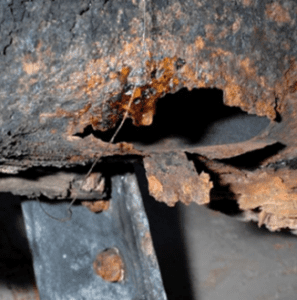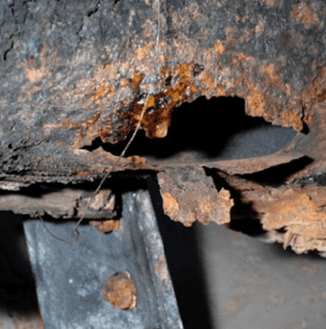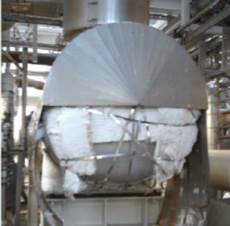The cart is empty!
CUI – A Pandemic Battle That Must Be Won
I think we can all agree that corrosion under insulation (CUI) is a major problem in the oil and gas industry. According to the Net Zero Technology Centre, corrosion:
- Costs the UK economy £28 billion every year
- Costs the world economy as much as £4 trillion annually
and CUI:
- Is responsible for one in five (20%) of the major oil and gas incidents in the EU since 1984
- Causes 60% of pipe failures
CUI detection is key to reducing the danger and cost of this unique corrosion mechanism. In this article, we look at the major inspection methods used to tackle the huge negative effects of CUI – and provide a quick summary of our new CUI training, and how you can book your place at a 20% discount.
CUI – Preventable by inspection?
Coatings can help prevent corrosion. But whatever the coating used, and the precautions employed, water tends to infiltrate the insulation over time, accelerating coating degradation along with chemistry and temperature.
For stainless steels, cracking can even occur where the coating looks visibly intact!
CUI often festers unidentified until equipment fails, but significant CUI can be surprisingly scattered and hard to find. The random time-dependent nature of stainless steel failures makes it challenging for periodic inspection to prevent the first failure.
For carbon steel, high inspection coverage at conservative intervals will prevent the majority of failures, but is very expensive even only for the highest consequence equipment, and all too often piping can fall through the gaps.
Industry is developing and improving anticorrosion coatings, insulation and cladding designs to delay the onset and severity of CUI, but it is surprisingly hard to prove what works to confidently relax inspection.
Inspection in the war against CUI
Detection is key to the early identification of CUI, and this is crucial to reducing the huge expense of reliable detection and catastrophic failures. The earlier CUI is identified, the more effective the repair and the cheaper it is to make. Yet we all know that reliable CUI inspection is an expensive operation itself – traditional inspection routines entailing removing the insulation, making the visual inspection, and then replacing the insulation.
While visual inspection of the insulation cladding is cost-effective, and can identify some water ingress locations, it is not possible to anticipate where all the CUI will be. Advanced inspection methods which don’t require removal of the insulation are still often expensive (though less destructive), and unfortunately all NDI techniques have limitations. These limitations prevent their widespread use for all insulated equipment components, and may not be as reliable as insulation removal. An 80% POD (probability of detection) may be effective for lower consequence of failure equipment, but it’s still expensive.
Water detection
Various technologies can detect wet insulation, e.g. thermography, neutron backscatter, and a new product developed with BP investment based on Compton backscatter called Moisture Detection Imaging. The latter claims more reliable water detection than the other methods, but the uncertainty is always whether periodic deployment can detect water in between insulation dry-out periods especially for higher operating temperatures. Uptake of water detection NDI techniques has varied considerably between different operators.
Radiography
Radiographic inspection technology can be deployed in many ways, including conventional radiography. This uses digital detector arrays (DDA) instead of film, and various roaming techniques including real-time radiography (RTR) with lower radiation intensity, which can detect corrosion product on carbon steel surfaces, and water detection for even lower radiation intensity, e.g. MDI.
Conventional radiography remains slow and expensive, with niche uses for small critical work scopes. SCAR (Small Controlled Area Radiography) can reduce the barriers required around the inspection area, and Oceaneering’s TAXITM can in some cases avoid interference with nucleonic plant instrumentation. However, high inspection coverage is not cheaper than insulation removal!
Real-time radiography (RTR) is a hand-deployed roaming inspection method implemented extensively in certain parts of the world, but safety concerns have seriously limited deployment in Europe. This is starting to change as European operators with KMs of simple-grade (at ground) piping spot the value of this tool; modifications to limit radiation exposure, and robot deployment are both current areas of interest. Still not a technique for rope access or where there is no access to both sides of the structure, detection reliability is not yet quantified. But as a screening technique that can cover 150m/day, it is a useful tool in the CUI toolkit.
Non-radioactive CUI testing
Another primary method of NDI CUI testing to not use radioactive sources is Pulsed Eddy Current.
A Pulsed Eddy Current (PEC) probe is placed onto insulation cladding, and a magnetic field is created within the transmitting coil in the probe. This penetrates the cladding, penetrates the pipe wall, and when the electrical current is switched off Eddy currents are created in the pipe wall.
The decay timing of the measured Eddy currents relates to a volumetric wall loss where detection limits and accuracy can vary with the volume morphology of the corrosion defects. Quoted detection limitations may not apply for all defects if generated by machined cylinders versus the actual shape of real corrosion defects. The type of defects that could be missed or not accurately measured can be significantly misunderstood, and HOIS is currently running a project to better understand this.
As with most CUI Non-Destructive Techniques (NDT) methods, PEC can only be used with carbon steel and low-alloy steel pipes, and measurements can be affected by nearby components interfering with generated magnetism, typically the very areas CUI is most likely to be located. PEC still has significant screening uses, but might miss some CUI and remains slow and expensive; its one big advantage is that it can be applied with one-sided access
There are other innovative hand-held inspection techniques being developed and trained in field trials including focused stress concentration tomography and Sub-Terahertz technology.
The rise of embedded sensors
CUI detection innovation is moving towards embedded sensor technology to detect water and/or corrosion which, if reliable, could significantly reduce the cost of NDT or insulation-driven inspection programs by replacing the need to scan the whole surface for CUI. Most of these sensors are in trial and test or early deployment phases – the most established being Corrosion Radar; the world’s first independent sensor testing JIP is currently ongoing in Belgium.
The big question is how to test and trust large networks of sensors, and will they be cost-effective?
But the rewards are huge! And we might find that sensors can help evaluate the effectiveness of different insulation designs and coatings.
ICORR – Dedicated to improving detection of CUI
Only if a non-corrosive material is developed will the need for testing be eliminated. Embedded sensors have the potential to significantly reduce the amount of inspection required. Until this is the case, each of the NDT methods outlined above has its own advantages and drawbacks. A combination of tests is usually recommended to help determine the exact nature of any CUI present, which can be very expensive, if only all the test methods existed in one single tool!
Here at ICORR, we are dedicated to helping the industry improve detection of CUI. We keep our members updated as to the latest developments in testing technology, and help them to develop their skills and ability within the industry.
View from the expert
 Dr Clare Watt, a key trainer in ICorr’s new Corrosion Under Insulation Program, says:
Dr Clare Watt, a key trainer in ICorr’s new Corrosion Under Insulation Program, says:
“With more than 25 years of experience in corrosion and integrity management, I have seen the damage that CUI can cause first-hand, as well as plenty of near misses. While some CUI failures represent mistakes or gaps, others represent newer coatings and insulation designs that, if not applied correctly, can speed up CUI!
“It takes a lot of inspection to find the scattered most severe CUI, which is why the cost of inspection is so high. On the other hand, if there was a technique to cheaply detect these locations, then the cost of inspection might reduce by 80-90% – and that is why CUI is still a hotbed of innovation!”
“The biggest challenge for the uptake of new technologies is proving what works, as this is only ever really determined after extended field deployment. It’s critical that the industry shares its CUI data to improve prediction, evaluate designs, and optimise inspection programs. Also, by sharing knowledge, we help to avoid mistakes and reduce unexpected failures of critical equipment.
“I’m passionate about improving CUI management strategies, and I’m proud to be a member of ICorr and a key trainer for the Corrosion Under Insulation Program. It is fully aligned with the core values of the Institute of Corrosion. It delivers more information than you’ll find in published industry guidance and recommended practices, updates on the latest industry innovations, and naturally broaden professional networks.”
CUI training with a difference
We’re proud to announce ICorr-accredited CUI training, providing participants who pass the one-hour exam on the last day of the two-day course with CUI Practitioner status.
Presented by Dr Clare Watt and Dr Steve Paterson, this fast-paced, engaging training will prove invaluable to all who are or with aspirations to be involved in the CUI field. Your learning will cover themes from the basics of CUI, to CUI management and monitoring, non-destructive CUI detection techniques to design considerations, innovation areas, and everything between.
Like our PFP training (and other ICorr-accredited corrosion courses) the certification and qualification you receive from this course upon passing the exam will confirm your competency within the field of CUI.
The first course will take place at ICorr’s HQ in Northampton on the 8th and 9th October. As a special offer in recognition of World Corrosion Day, we’re offering a discounted price of £1,800 without examination and £1,900 with examination – a 20% discount to the standard price. To learn more about the course and book your place, contact our ICorr admin department today.



